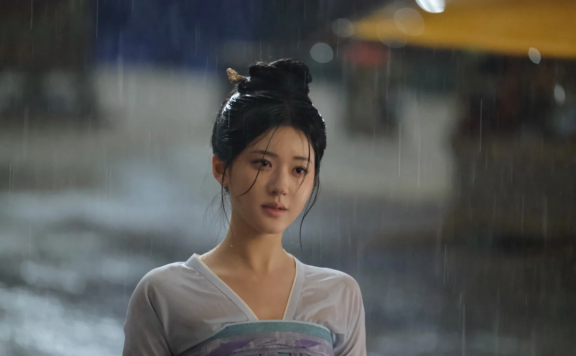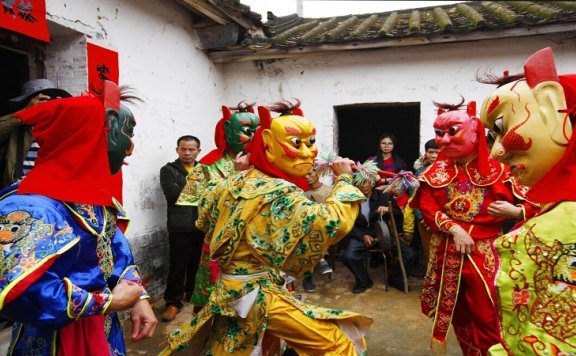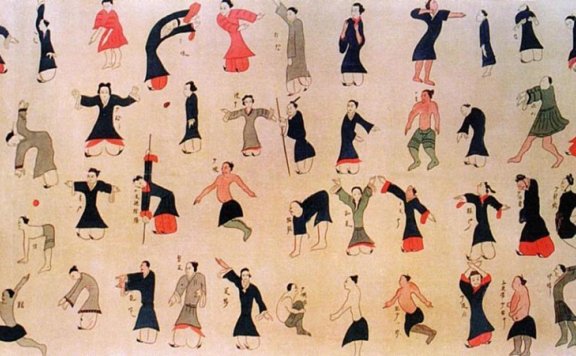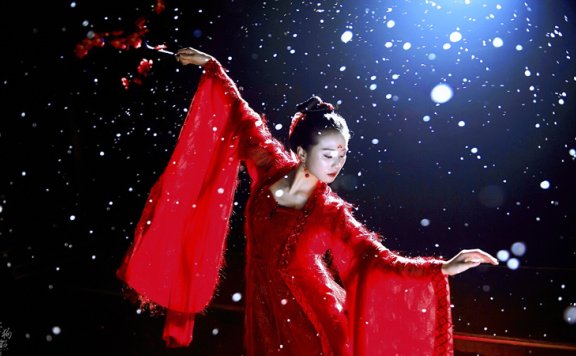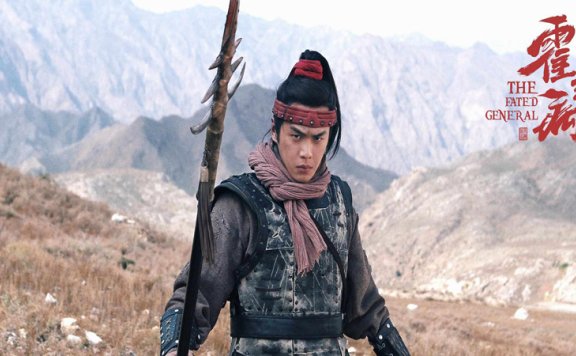Article
搜索结果:
-
Is Appearance Anxiety the Fault of Our Era?
The recent discussion on 'appearance anxiety' reminds me of the Tang Dynasty, a period that might offer some inspiration for those struggling with such concerns today. The Tang Dynasty was renowned for its inclusivity and openness, setting what could be considered the 'international beauty standard' of its time. Contrary to the common misconception that Tang women were simply 'plump,' their beauty was more about robust health and fullness. From the slender figures of the early Tang to the more voluptuous forms of its peak, ancient artworks depict a diverse range of body types, showcasing a true celebration of variety. Historical records, like the 'New Book of Tang: Biographies of Imperial Princesses,' describe figures such as Princess Taiping and Empress Wu Zetian with 'broad foreheads and wide cheeks'—features that starkly contrast with today's mainstream beauty ideals. Modern preferences lean towards narrow foreheads, low hairlines, large round eyes, and small faces, often labeling broader features as less desirable. Yet, the Tang aesthetic was rooted in health and confidence, where natural, unforced beauty reflected the dynasty's prosperity. Dunhuang murals further illustrate this, portraying female donors with double chins, visible neck lines, rounded faces, and even slight bellies—features that, while differing from Western ideals… -
The Fascinating History of Futou: A Hat Worn by Chinese Men
In many Tang and Song dynasty dramas, you'll notice that almost every male character wears the same type of hat—the Futou. Whether they're high - ranking officials, low - level clerks, or military generals, the Futou is a common sight. This raises the question: was this hat really that ubiquitous in ancient China? The Futou, also known as the 'Zheshang Jin' (折上巾), was the most popular headwear for men during the Tang dynasty. It originated from a simple headscarf and evolved into two main styles: the 'soft wrap' and the 'hard wrap.' The soft wrap involved directly tying the cloth around the head, while the hard wrap used a base called 'Jinzi' (巾子) to create a more structured shape. The design of the Jinzi varied slightly over time. Historical records, such as Shen Kuo's 'Dream Pool Essays' from the Song dynasty, describe the Futou's tying method in detail. It involved four straps: two tied at the back, leaving two dangling, and the other two folded and tied at the top, giving it the nickname 'Zheshang Jin'. This style was particularly popular among military personnel, as noted in the 'Tang Huiyao.' Despite its widespread use, the Futou wasn't universal. Emperors wore… -
Did Ancient Chinese Use Umbrellas on Sunny Days?
We all know that ancient Chinese used umbrellas on rainy days, but did they also use them for sun protection on sunny days? In historical dramas, oil-paper umbrellas are no longer just for rain but have become props to create an aesthetic atmosphere. They are often seen in scenes where the protagonist walks slowly under a bright sun with an oil-paper umbrella. While beautiful, these umbrellas are made of paper—can they withstand prolonged exposure to sunlight? The answer is simple: ancient Chinese were clever. While oil-paper umbrellas weren’t practical for sunny days, they had other types of umbrellas specifically designed for sun protection. For example, during the Western Zhou Dynasty, umbrellas made of silk (bo) were used, though their primary purpose wasn’t sun protection but to signify noble status. The Northern Qi Dynasty had strict regulations: kings and high-ranking officials used purple umbrellas with pheasant tail decorations, while lower-ranking officials and scholars used blue umbrellas with green linings. The "Yuxie" records that during the Wei Dynasty, people invented oil-paper umbrellas by splitting bamboo and coating paper with oil for daily convenience. During the Qin and Han Dynasties, elaborate canopies (huagai) became popular. The painted bronze chariot unearthed from the Mausoleum… -
The Fashion Trend of Bird Crowns in Ancient China
In ancient China, a unique fashion trend emerged where women adorned their heads with bird - shaped crowns. This practice, which might seem extravagant today, was quite popular among the nobility and performers during various dynasties. The tradition of wearing bird crowns dates back to the Northern Qi Dynasty, as evidenced by murals in the Xu Xianxiu Tomb. By the Tang Dynasty, these crowns became a favorite among female dancers and attendants. Historical records, such as Tang Du You's 'Tongdian' and the 'New Book of Tang,' document performances where dancers wore bird crowns and colorful costumes to celebrate imperial achievements. Initially used by performers, bird crowns gradually gained popularity among the aristocracy. Crafted from gold and silver and embellished with precious stones, these crowns featured various birds like peacocks, phoenixes, parrots, and mynas. The Dunhuang murals frequently depict these ornate crowns, especially on princesses from Khotan and Uyghur, adorned with jade and dressed in luxurious robes. A notable example is a Tang Dynasty pottery figurine from the Jinxiang County Princess Tomb, wearing a peacock crown with vividly painted feathers. The phoenix crown held a special status, combining features of multiple birds, as described in Zhang Hua's 'Avian Classic.' Phoenix motifs… -
Ren Min's Eyebrow Transformation in Splendid Peace
In the popular drama 'Splendid Peace,' Ren Min's makeup has garnered significant attention, particularly her eyebrows, which dramatically enhance her facial features. In traditional Chinese makeup, the 'Emei' (蛾眉) or 'Moth Eyebrows' have been a long - standing trend. Described in ancient texts like 'Chu Ci' (楚辞) and 'Li Sao' (离骚), these eyebrows are slender, curved, and long, resembling the antennae of a silkworm moth. Historically, silkworm farming was a vital agricultural tradition, and even empresses participated in sericulture rituals, making the moth - inspired makeup unsurprising. Over time, the term 'Emei' evolved from a specific style to a general reference for various eyebrow shapes. For instance, during the Tang and Song dynasties, styles like 'Echi' (蛾翅) or 'Chuizhu Mei' (垂珠眉) emerged. In 'Splendid Peace,' Ren Min sports the 'Yueleng Mei' (月棱眉), also known as 'Qu Yue Mei' (却月眉), which resembles a crescent moon with a sharp upper edge and a softly blended lower edge. Other similar styles include 'Lianjuan Mei' (连娟眉), 'Liu Ye Mei' (柳叶眉), and 'Yuanshan Mei' (远山眉). These curved, elongated eyebrows suit most face shapes but are particularly flattering for round or broad faces, adding a sense of space and layered beauty reminiscent of Chinese ink paintings.… -
The Etiquette of Twelve Hairpins in Ancient China
Have you ever been puzzled by scenes in historical dramas like 'The Willow Boat' where characters debate whether 'Twelve Hairpins' are appropriate for a certain rank? Today, let's delve into the significance of these 'Twelve Hairpins'. A key term here is 'Huashu' (花树), which refers to floral hair ornaments. The practice of using the number of Huashu to denote rank began in the Sui and Tang dynasties, with the quantity corresponding to the wearer's status. Similarly, 'Dianchai' (钿钗), or jeweled hairpins, followed this system but were worn with different ceremonial attire. For example, the Tang Empress wore twelve Huashu (小花如大花之数,并两博鬓), while the Crown Princess wore nine. Noblewomen of various ranks wore between five and nine Huashu, adorned with precious jewels. These ornaments, made of delicate gold and silver petals, were prone to damage, which is why archaeological finds often reveal only fragments. Contrary to expectations, these 'flowers' sometimes included tiny figurines. One might wonder how noblewomen managed the weight and complexity of wearing so many ornaments. The ingenious solution was the 'Bijì' (蔽髻), a crown-like frame that could hold multiple Huashu clusters, simplifying the process of adorning one's hair. To secure the Bijì, two elaborately decorated long hairpins were inserted… -
Dior's Use of Chinese Velvet Flowers Sparks Debate
Dior has once again incorporated Chinese velvet flower craftsmanship into its designs, this time on a brimless cap showcased at Paris Fashion Week. This move, while seen as a tribute to Chinese aesthetics, has reignited discussions about cultural appropriation and the importance of preserving traditional Chinese crafts. Velvet flowers, known as Ronghua (绒花) in Chinese, have a rich history dating back centuries. Initially popularized during the Tang and Song dynasties, these intricate silk flowers became a staple in both imperial courts and folk traditions. Their use in festivals, weddings, and daily adornment reflects the Chinese love for floral symbolism and auspicious meanings. Historically, velvet flower production flourished in cities like Nanjing and Yangzhou, where silk waste from brocade manufacturing provided ample material. Artisans developed regional styles: southern Ronghua favored bold colors, while northern versions leaned towards dignified hues like imperial red. Modern challenges face this traditional craft. While appearing in period dramas and international events like the Winter Olympics has revived interest, mass-produced alternatives threaten the survival of authentic handmade Ronghua. Each genuine piece still requires ten meticulous steps over two days of labor-intensive work. The Dior controversy highlights a broader issue: as global brands increasingly adopt Chinese elements, domestic… -
Top 10 Famous Temples in Jiangxi China
Jiangxi is a central hub of Buddhist culture in China, where Buddhism has flourished significantly. Many influential Buddhist sects, such as the Pure Land School dominant in China and those prevalent in Japan and the West, trace their origins to Jiangxi. The region boasts numerous renowned temples. Here, we present a curated list of the top 10 famous temples in Jiangxi, highlighting their historical and cultural significance. 1. **Donglin Temple (Lushan)** - **Established**: Eastern Jin Dynasty Located in the scenic Lushan Mountain area, Donglin Temple is one of China's eight major Buddhist sites. With its grand architecture and serene environment, it houses many precious relics. It is revered by Japan's Pure Land School and is one of Jiangxi's three international Buddhist exchange centers. 2. **Youmin Temple (Nanchang)** - **Established**: Liang Dynasty (Southern Dynasties) A cradle of the Hongzhou Zen School, Youmin Temple has long been a pilgrimage site in East and Southeast Asia. As Nanchang's only fully preserved temple, its unique architecture exudes historical charm. 3. **Baofeng Temple (Jing'an County)** - **Established**: Tang Dynasty (Tianbao Era) With 24 halls and over 800 statues, Baofeng Temple features landmarks like the Nine - Dragon Wall and a liberation pond. Its deep ties… -
Top 10 Must-Visit Landmarks in China
China boasts a wealth of cultural and natural landmarks that attract millions of visitors each year. Here’s a curated list of the top 10 must-visit landmarks, based on popularity and significance. 1. The Forbidden City (Beijing) The Forbidden City, or Zijincheng (紫禁城), is a masterpiece of ancient Chinese architecture. Spanning 720,000 square meters, it features over 870 palaces and is the world’s largest and best-preserved wooden structure. Its intricate designs and historical artifacts make it a must-see. 2. Yarlung Tsangpo Grand Canyon (Nyingchi) Located in Tibet, the Yarlung Tsangpo Grand Canyon stretches 504.6 kilometers with a maximum depth of 6,009 meters. It showcases diverse landscapes, from glaciers to rainforests, making it a paradise for nature lovers. 3. Mogao Caves (Dunhuang) The Mogao Caves, or Qianfodong (千佛洞), are a treasure trove of Buddhist art. With 735 caves, 45,000 square meters of murals, and 2,400 painted sculptures, they reflect the cultural fusion of China, India, and Central Asia along the Silk Road. 4. Terracotta Warriors (Xi’an) Discovered in the mausoleum of Emperor Qin Shi Huang, the Terracotta Army includes over 8,000 life-sized soldiers and horses. Each figure is uniquely detailed, showcasing the military prowess of the Qin Dynasty. 5. Leshan Giant Buddha… -
The Three Great Murals of China Come to Beijing
China's ancient murals tell stories beyond words—tales of gods and mortals, of cultural exchange along the Silk Road, and of imperial artistry at its finest. While these masterpieces are scattered across distant temples and caves, Beijing is now hosting an unprecedented convergence of the nation's most treasured mural art. For anyone with a love of history, color, and storytelling, this is an exhibition season not to be missed. When it comes to Chinese mural art, three sites stand above all others. The Dunhuang murals, covering the walls of the Mogao Caves (莫高窟), present a thousand-year visual chronicle of the Silk Road, where Buddhist, Persian, and Chinese influences intertwine in dazzling hues. The Yongle Palace (永乐宫) murals in Shanxi, home to the legendary Chaoyuan Tu (Pilgrimage of the Celestial Worthies诸神朝元图), represent the pinnacle of Daoist artistic expression, their figures alive with movement and grandeur. Finally, Fahai Temple (法海寺) in Beijing, though lesser-known, holds some of the most refined Ming Dynasty murals, created with the highest level of palace artistry. This year, for the first time, all three converge in Beijing through major exhibitions, offering a rare chance to appreciate these artistic treasures side by side. Fahai Temple: The Hidden Gem of… -
Li Xian's Pink Round-Collar Robe in Guo Se Fang Hua
Recent promotional images from the drama 'Guo Se Fang Hua' have surfaced online, featuring actor Li Xian in a pink round - collar robe and a traditional Futou (幞头) headpiece. The bold choice of color has left netizens astonished, with many questioning whether men in the Tang Dynasty actually wore such vibrant shades of pink. In traditional Chinese culture, the color 'pink' encompasses a wide spectrum of elegant names, such as 'Tao Yao' (桃夭, peach blossom), 'Yan Zhi' (胭脂, rouge), 'Bao Chun' (报春, herald of spring), 'Fei Se' (妃色, concubine's hue), and 'Su Mei' (苏梅, plum blossom). Unlike standardized Pantone colors, traditional Chinese hues vary in depth and tone, each carrying its own unique cultural significance. Pink has long symbolized beauty and vitality in Chinese history. Ancient poets often used terms like 'Tao Hong' (桃红, peach red) or 'Tao Yao' to describe the radiant complexion of beautiful women. For instance, the line 'Tao Zhi Yao Yao, Zhuo Zhuo Qi Hua' (桃之夭夭,灼灼其华) from the 'Book of Songs' not only depicts blooming peach blossoms but also evokes an image of delicate yet vibrant charm. Historical records and artifacts reveal that pink was a popular color in various dynasties. The Dunhuang Mogao Caves,… -
The Living Spirit of Chinese Folk Performance
With the recent announcement of China's sixth batch of national intangible cultural heritage inheritors, Guangdong has become a focal point, with 58 individuals recognized for their dedication to preserving arts like Guangdong Lion Dance (广东醒狮), Cantonese Opera (粤剧), and Chaozhou Opera (潮剧). Among these honorees are practitioners of some of China's most enigmatic folk traditions—Nuó Dance (傩舞), Qilin Dance (麒麟舞), and Panwang Festival (盘王节). Each of these embodies the resilience of Chinese folk culture, preserving both its mystical essence and regional identity. But what cultural significance do they hold? How do their inheritors sustain them in modern times? Let's step into the world of these mesmerizing traditions. Nuó Dance: A Ritual Frozen in Time "Nuó Dance is deeply rooted in our village's traditions. It has been passed down for generations, and everyone, from elders to children, participates with enthusiasm," says Peng Qiusheng, a newly recognized national inheritor from Jiuxian Village (旧县村) in Zhanjiang (湛江). Nuó (傩), an ancient ritual performance, traces its origins back to the Zhou Dynasty (西周). It was initially a shamanistic practice to ward off evil spirits and seek divine blessings for favorable weather and bountiful harvests. Over centuries, it evolved into a dramatic art form encompassing… -
Seasonal Health Tips: Ancient Wisdom for Wellness
When spring arrives, so does that overwhelming drowsiness. Some of us reach for an iced coffee, while others hit the gym to shake off the fatigue. But these modern solutions only offer temporary relief. If we truly want to stay energized, why not take a page from ancient wisdom? From the traditional lifestyle of "rising with the sun and resting at dusk" to the proactive health philosophy of "preventing illness before it arises," our ancestors mastered the art of well-being. Let's explore their secrets through ancient artifacts and uncover seasonal health tips that still applies today. Spring: Wake Up Your Body with Daoyin Exercises The Huangdi Neijing (黄帝内经), an ancient Chinese medical text, states: "In the three months of spring, one should go to bed late and rise early, take walks in the courtyard, and embrace the vitality of the season." This advice highlights the essence of spring wellness—waking up early and engaging in physical activity to rejuvenate the body. Over 2,000 years ago, people already practiced a form of breathing-based exercise known as Daoyin (导引), an early form of qigong. The Daoyin Tu (导引图), an ancient scroll excavated from the Mawangdui (马王堆) Han tombs, depicts 44 figures performing various… -
Oracle Bone Script: The Empire's Big Data Archives
The earliest known mature writing system in China, oracle bone script (Jiaguwen, 甲骨文), emerged during the late Shang Dynasty (商, 14th to 11th centuries B.C.). Carved onto tortoise shells and animal bones, these inscriptions preserve the historical memory and cultural codes of early Chinese civilization. As both the "childhood form" of Chinese characters and a mirror reflecting the Shang and Zhou societies, they offer invaluable insights into ancient governance, religion, technology, and art. Since their rediscovery in 1899, oracle bone inscriptions have opened a 3,000-year-old historical window, embodying the weight of "one word, one history" and serving as a cornerstone for understanding Chinese cultural roots. From Knife to Brush, the Origins of Calligraphy Oracle bone inscriptions were carved using bronze or jade knives, resulting in thin, sharp, and angular strokes that exhibit a unique "knife-carved aesthetic." The characters vary in size and spacing—such as "sacrifice" (Ji, 祭), resembling a symmetrical altar, or "deer" (Lu, 鹿), whose simple curves suggest antlers and hooves. These early inscriptions laid the foundation for later Chinese calligraphy, influencing scripts like Jinwen (金文, Bronze Inscriptions) and Seal Script (徽书, Zhuanshu). Many oracle bone characters retain strong pictographic elements. For example, "mountain" (Shan, 山) depicts three peaks,… -
Liu Yifei's 5 Must-Watch Historical Hits
Hey, ever wanted to see a real-life fairy kick butt in ancient China? Meet Liu Yifei (刘亦菲) — the actress who's been slaying wuxia swords, brewing Song Dynasty tea, and redefining warrior princesses since she was 14. Whether you're here for the sword fights or the feels, Liu Yifei's roles are your next binge-watch obsession. Return of the Condor Heroes 神雕侠侣 Aired: 2006 Period Background: Southern Song Dynasty (13th century) Genres: Wuxia, romance, adventure Main Roles: Liu Yifei as Xiaolongnü (小龙女), Huang Xiaoming as Yang Guo (杨过) Adapted From: Jin Yong's (金庸) classic wuxia novel The Return of the Condor Heroes Return of the Condor Heroes isn't just a drama—it's the ultimate wuxia rollercoaster. Liu Yifei's breakout role as Xiaolongnü (Little Dragon Girl) turned her into an overnight icon, and for good reason: this series has everything. Sword fights on bamboo forests? Check. Forbidden romance that'd make Shakespeare sweat? Double-check. A heroine who can kill you with a silk ribbon? Oh yeah. The Setup: Xiaolongnü isn't your average girl-next-door. Raised in the Tomb of the Living Dead (活死人墓—yes, that's its actual name) by her reclusive sect, she's mastered ancient martial arts but knows zilch about the outside world. Enter Yang… -
Hu Ge's Best 7 Costume Drama Hits
If you've ever wondered why Hu Ge (胡歌) is called the "King of Chinese Costume Dramas," his roles speak louder than titles. From sword-wielding heroes to cunning strategists, he's brought China's past to life for over 20 years—and his shows are a perfect starting point for anyone curious about Chinese history, myths, and storytelling. No frills, no jargon—just great stories that mix action, romance, and a slice of ancient China. Let's break down his best costume hits and why they're worth your watchlist. Chinese Paladin: Sword and Fairy 仙剑奇侠传 Aired: 2005 Period Background: Mythical Ancient China (Wuxia/Xianxia genre) Genres: Fantasy, Romance, Adventure Main Roles: Hu Ge (Li Xiaoyao), Liu Yifei (Zhao Ling'er), An Yixuan (Lin Yueru) Adapted From: The Sword and Fairy RPG game by Softstar Entertainment. Li Xiaoyao isn't your typical hero. He starts as a carefree, slightly lazy innkeeper in a small coastal village, cracking jokes and dodging responsibility. But when his aunt falls mysteriously ill, he's forced to leave home and seek a cure. What begins as a simple rescue mission quickly spirals into an epic adventure. Along the way, he meets Zhao Ling'er, a gentle but enigmatic girl with a secret lineage tied to ancient immortals,… -
7 Must-Watch Cheng Yi Period Dramas
If you've ever binge-watched a Cheng Yi (成毅) drama, you know two things: he loves a good costume, and he'll make you cry—or cheer—without saying a word. From mystical immortals to scheming emperors, Cheng Yi has become the go-to actor for Chinese historical and fantasy dramas that hook viewers with their mix of heartbreak, sword fights, and intricate plots. Let's dive into his top period dramas—where every flick of his sleeve or subtle glance tells a story. Love and Redemption 琉璃 Aired: 2020 Period Background: Set in a mythical ancient China Genres: Xianxia, Romance, Fantasy Main Roles:Cheng Yi as Yu Sifeng (禹司凤), Yuan Bingyan (袁冰妍) as Chu Xuanji (褚璇玑) Adapted From: The novel Liu Li Mei Ren Sha (琉璃美人煞) by Shi Si Lang (十四郎) At its core, Love and Redemption is a saga of cosmic love and redemption spanning ten reincarnations. Yu Sifeng, a noble yet cursed disciple, falls for Chu Xuanji, whose fragmented soul lacks emotional awareness due to her divine origins. Each lifetime, Sifeng sacrifices himself to protect her—whether by taking lethal blows, enduring soul-crushing betrayal, or surrendering his spiritual essence—only to watch her forget him repeatedly. Xuanji's journey to regain her "heart" mirrors her awakening as the… -
5 Liu Shishi Costume Classics to Binge
Liu Shishi's (刘诗诗) costume dramas have a unique charm. Whether she plays a gentle yet resilient heroine or a bold and fearless warrior, she always brings her characters to life. Today, let's dive into her top five costume classics and see which one stands out as your favorite. Bu Bu Jing Xin / Startling by Each Step 步步惊心 Aired: 2011 Period Background: Qing Dynasty (17th–18th century) Genres: Time-travel romance, political intrigue Main Roles: Liu Shishi as Zhang Xiao/ Ruoxi (若曦), Nicky Wu as Fourth Prince Yinzhen (胤禛) Adapted From: Tong Hua's (桐华) novel Bu Bu Jing Xin If you've ever daydreamed about time travel, Bu Bu Jing Xin (BBJX) is the drama that will make you rethink that fantasy. Forget glossy escapism—this series drops a modern woman into the cutthroat politics of the Qing Dynasty and asks: What if you knew how history would unfold, but couldn't change it? The Setup: Zhang Xiao (Liu Shishi), a 21st-century office worker, wakes up in 1711 as Maertai Ruoxi, a noblewoman entangled with Kangxi Emperor's sons. Her modern sensibilities clash with rigid imperial rules, but her knowledge of history (thanks to history books) becomes both a weapon and a curse. The Storm: The… -
The 8 Great Chinese Cuisines and Iconic Dishes
Unlike Western culinary classifications by courses or ingredients, Chinese cuisine categorizes itself through philosophical flavor balance and geographical personality. The eight recognized styles - Shandong (鲁菜), Sichuan (川菜), Cantonese (粤菜), Jiangsu (苏菜), Zhejiang (浙菜), Fujian (闽菜), Hunan (湘菜), and Anhui (徽菜) - each developed unique characteristics shaped by local topography, historical trade routes, and imperial influences. The eight cuisines follow different culinary principles - Cantonese chefs prioritize Wok Hei (breath of the wok 锅气) through quick frying, while Anhui cuisine employs slower braising methods to extract depth from mountain herbs and preserved goods. Understanding the "Eight Great Cuisines" (八大菜系) provides the key to appreciating Chinese complex edible culture. As we examine each cuisine's signature techniques, historical influences, and philosophical underpinnings, prepare to discover how imperial edicts shaped flavor preferences and how climate dictated regional preservation methods that became beloved flavors. Shandong Cuisine Rooted in the fertile plains and rugged coastlines of eastern China, Shandong Cuisine stands as the grand progenitor of China's culinary traditions, its influence radiating through royal kitchens and humble hearths for over 2,500 years. Born in the homeland of Confucius, this cuisine marries the pragmatism of northern Chinese life with the poetic discipline of ancient rituals, creating… -
Zhang Ruoyun: 5 Costume Masterpieces Ranked
If you're new to Chinese historical dramas, Zhang Ruoyun's (张若昀) name should be at the top of your list. Forget stiff period pieces—his shows mix sharp wit, high-stakes politics, and characters who feel real, even in silk robes. Whether he's playing a math genius in the Ming Dynasty or a warrior prince in a fictional empire, Zhang makes centuries-old stories crackle with modern energy. Let's cut to the chase: here are his five best costume masterpieces to binge next. Joy of Life 庆余年 Aired: Season 1 (2019), Season 2 (2024) Period Background: Fictional Qing Dynasty-inspired empire Genres: Political intrigue, Historical fantasy, Mystery Main Roles: Fan Xian (范闲): Zhang Ruoyun as a witty, modern-minded nobleman navigating court conspiracies. Emperor Qing (庆帝): Chen Daoming (陈道明) as the enigmatic ruler. Adapted From: Cat Nip's novel Joy of Life. If you've ever wondered what Game of Thrones might look like with a Chinese twist—minus the dragons but packed with biting humor and brainy schemers—Joy of Life is your answer. Zhang Ruoyun's breakout role as Fan Xian redefined historical fantasy, blending time-travel logic, political chess games, and a protagonist who'd feel just as at home in a coffee shop as in a royal palace. Aired in two…
